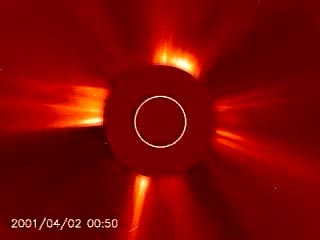 |
|
A
series of coronal mass ejections (CMEs)
from April 2-6. Images taken by the LASCO
instrument aboard the SOHO spacecraft.
(Click
to launch movie.)
|
|
|
A few times every day during solar maximum
conditions, the Sun can let loose a titanic blast of material.
For days, a cloud of plasma can be suspended by magnetic pressures
just above the photosphere in a region called the chromosphere.
Then, for reasons not fully understood, this billion-ton cloud
can become unhinged and be propelled away from the Sun. The
cloud is only a small part of a larger blast of coronal material
that forms a large loop or bubble rising through the lower
reaches of the solar corona, the Sun's outer atmosphere. The
cloud expands and accelerates enormously to speeds of millions
of kilometers per hour. Within a few days, the cloud has reached
the orbit of Earth, having passed Venus and Mercury on its
way. In time, these coronal mass ejections, or CMEs as they
are called, cause interplanetary space to be filled with a
changing mosaic of cloud fragments and magnetic field blobs,
millions of kilometers across, and flowing outward in a great
pinwheel pattern, to beyond the orbit of Pluto.
Each CME Unique
No two CMEs are exactly the same,
so astronomers describe these explosions by average properties,
just as we often say that the average human being is about
6 feet tall. CMEs are actually not very dense by the time
they reach the Earth's orbit. As they expand through space,
their density falls from millions of particles per cubic centimeter
near the Sun, to barely a dozen particles per cubic centimeter
near Earth. Most of them travel at nearly one million kilometers
per hour and take 2-4 days to get to Earth's orbit. The fastest
ones can travel at nearly three times this speed and get to
Earth within a day. Many of them are actually quite hollow
and resemble enormous soap bubbles blown into space by the
Sun.
Earth's Protective Shield
As spectacular as these solar storms
can be, there is little cause for concern that the Earth's
atmosphere will be 'blown away' by them. A CME blast wave
is actually a better vacuum than what you would find in a
television picture tube, but this doesn't mean that they are
completely without any consequence. As they sweep past Earth,
they distort Earth's magnetic field causing its Sun-ward side
to be pushed inside the orbits of geosynchronous communication
satellites. Satellite outages and other problems can then
ensue as delicate electronics are battered by hailstorms of
energetic CME particles. In other parts of Earth's magnetic
field, powerful currents of particles become energized and
flow into the polar regions causing the Northern and Southern
Lights.
 Find out more
about the Sun-Earth Connection at the Sun-Earth
Connection Education Forum Web site.
Find out more
about the Sun-Earth Connection at the Sun-Earth
Connection Education Forum Web site.
Text adapted from the
Sun-Earth Connection Tutorial courtesy of NASA, originally
written by Dr. Sten Odenwald. Images and videos courtesy of
NASA unless otherwised noted.
|